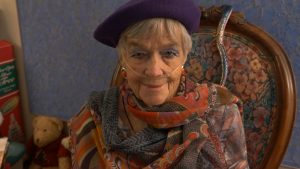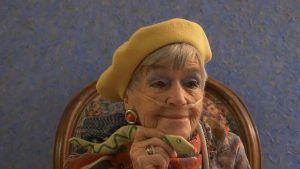Mary Jean Place: Focusing on what matters most
February 2017
For all of her 88 years, Mary Jean Place has been a person who takes initiative. When she wanted to learn about art, she developed a plan for investing her money and time. When local libraries needed funding, she helped create a foundation to raise support.
And when, more than a decade ago, she was diagnosed with an incurable lung disease, Mary Jean completed her Advance Health Care Directive and talked to her family about her end-of-life wishes.
“I’ve been really impressed and inspired by Nana’s straightforwardness in letting us know what is going on with her,” says her granddaughter Adele Fournet. “I appreciate that, because I don’t have to guess what she wants or would have liked.”
Part of Mary Jean’s take-charge plan was to begin hospice care as soon as she was eligible, more than two years ago. Her Mission Hospice team members – Dr. Howard Lee, RN Case Manager Chris Brady, Social Worker Liz Stein, Spiritual Counselor MK Nelson, Nurse Practitioner Anna Woods, and volunteer Bob Adams – have helped her learn to manage her breathing and the increased challenges of living with a terminal illness.
They also facilitated a recent trip to southern California with one of her daughters, handing off care to a local hospice program.
“One of the reasons Mary Jean wanted to get hospice care early,” says MK, “was to have a team in place as she declined, enabling her to stay at home until the very end.”
 That home is filled with large pieces of modern art, a sort of theme for what Mary Jean calls her “itinerant life,” which has crossed the US and Europe.
That home is filled with large pieces of modern art, a sort of theme for what Mary Jean calls her “itinerant life,” which has crossed the US and Europe.
“I became interested in art when I was in third grade,” she says, remembering a photo of a Raphael painting in the Weekly Reader. ”I never forgot that picture.”
The Weekly Reader turned out to be emblematic of a second important part of her life: printed material. Mary Jean earned degrees in philosophy and library science, and worked for many years as a reference librarian.
When her career took her to Stuttgart in the 1950s, she saw this as a chance to immerse herself in the great art of Europe. “I used half of the money left over after paying bills to buy contemporary art,” she says. “The other half went to museum admissions. It was a very good way to learn, and I came home with a lot of art.”
 Once she settled in the Bay Area in the late sixties, Mary Jean became a community leader, serving on the Palo Alto Library Commission and co-founding a library foundation. She opened an art gallery in San Francisco, worked for 35 years as an art consultant, and volunteered as a Palo Alto Arts Commissioner.
Once she settled in the Bay Area in the late sixties, Mary Jean became a community leader, serving on the Palo Alto Library Commission and co-founding a library foundation. She opened an art gallery in San Francisco, worked for 35 years as an art consultant, and volunteered as a Palo Alto Arts Commissioner.
At 74, she spent two years in Paris, soaking up art once again, and starting her iconic collection of berets.
As Mary Jean’s breathing has become increasingly difficult, support from her family and her Mission Hospice team allows her to continue with a number of projects, including planning her memorial service.
“For the end of your life to be the way you want,” says Mary Jean, “you have to be responsible. You have to play an active role.”
Adds Adele, “My grandmother is a classy lady. She is stylish, she knows how to throw a good party, she makes meaningful social connections. The way she is planning for her death and her memorial is a natural extension of that classiness into her final chapters.”
